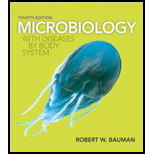
Concept explainers
(1)
To determine:
What the man suffered from; what the antibodies were against; what the dark-staining bodies in his brains cells were; what the preventive measures are that might be used by the healthcare workers to save the man’s life.
Case summary:
A man with a neurological disorder (anxiety, feelings of fear, and unrestrained facial twitching) reached an emergency room. He also developed swallowing difficulties, itching, and sore throat. He negated to drink water due to swallowing difficulties. He frequently vomited and his body temperature is increased (106ºF). He died after being admitted in the hospital for one week. Increased antibody titer (blood) and dark-staining bodies (brain cells) are discovered after the autopsy. Through investigations, his family and friends mentioned that a bat had landed on his face.
(2)
To determine:
What the antibodies were against.
Case summary:
A man with a neurological disorder (anxiety, feelings of fear, and unrestrained facial twitching) reached an emergency room. He also developed swallowing difficulties, itching, and sore throat. He negated to drink water due to swallowing difficulties. He frequently vomited and his body temperature is increased (106ºF). He died after being admitted in the hospital for one week. Increased antibody titer (blood) and dark-staining bodies (brain cells) are discovered after the autopsy. Through investigations, his family and friends mentioned that a bat had landed on his face.
(3)
To determine:
What the dark-staining bodies in his brains cells were.
Case summary:
A man with a neurological disorder (anxiety, feelings of fear, and unrestrained facial twitching) reached an emergency room. He also developed swallowing difficulties, itching, and sore throat. He negated to drink water due to swallowing difficulties. He frequently vomited and his body temperature is increased (106ºF). He died being admitted in the hospital for after one week. Increased antibody titer (blood) and dark-staining bodies (brain cells) are discovered after the autopsy. Through investigations, his family and friends mentioned that a bat had landed on his face.
(4)
To determine:
What the preventive measures are that might be used by the healthcare workers to save the man’s life.
Case summary:
A man with a neurological disorder (anxiety, feelings of fear, and unrestrained facial twitching) reached an emergency room. He also developed swallowing difficulties, itching, and sore throat. He negated to drink water due to swallowing difficulties. He frequently vomited and his body temperature is increased (106ºF). He died after being admitted in the hospital for one week. Increased antibody titer (blood) and dark-staining bodies (brain cells) are discovered after the autopsy. Through investigations, his family and friends mentioned that a bat had landed on his face.
Want to see the full answer?
Check out a sample textbook solution
Chapter 20 Solutions
Microbiology with Diseases by Body System (4th Edition)
- Describe the principle of homeostasis.arrow_forwardExplain how the hormones of the glands listed below travel around the body to target organs and tissues : Pituitary gland Hypothalamus Thyroid Parathyroid Adrenal Pineal Pancreas(islets of langerhans) Gonads (testes and ovaries) Placentaarrow_forwardWhat are the functions of the hormones produced in the glands listed below: Pituitary gland Hypothalamus Thyroid Parathyroid Adrenal Pineal Pancreas(islets of langerhans) Gonads (testes and ovaries) Placentaarrow_forward
- Describe the hormones produced in the glands listed below: Pituitary gland Hypothalamus Thyroid Parathyroid Adrenal Pineal Pancreas(islets of langerhans) Gonads (testes and ovaries) Placentaarrow_forwardPlease help me calculate drug dosage from the following information: Patient weight: 35 pounds, so 15.9 kilograms (got this by dividing 35 pounds by 2.2 kilograms) Drug dose: 0.05mg/kg Drug concentration: 2mg/mLarrow_forwardA 25-year-old woman presents to the emergency department with a 2-day history of fever, chills, severe headache, and confusion. She recently returned from a trip to sub-Saharan Africa, where she did not take malaria prophylaxis. On examination, she is febrile (39.8°C/103.6°F) and hypotensive. Laboratory studies reveal hemoglobin of 8.0 g/dL, platelet count of 50,000/μL, and evidence of hemoglobinuria. A peripheral blood smear shows ring forms and banana-shaped gametocytes. Which of the following Plasmodium species is most likely responsible for her severe symptoms? A. Plasmodium vivax B. Plasmodium ovale C. Plasmodium malariae D. Plasmodium falciparumarrow_forward
- please fill in missing parts , thank youarrow_forwardplease draw in the answers, thank youarrow_forwarda. On this first grid, assume that the DNA and RNA templates are read left to right. DNA DNA mRNA codon tRNA anticodon polypeptide _strand strand C с A T G A U G C A TRP b. Now do this AGAIN assuming that the DNA and RNA templates are read right to left. DNA DNA strand strand C mRNA codon tRNA anticodon polypeptide 0 A T G A U G с A TRParrow_forward
- Lifetime Physical Fitness & WellnessHealth & NutritionISBN:9781337677509Author:HOEGERPublisher:Cengage
 Comprehensive Medical Assisting: Administrative a...NursingISBN:9781305964792Author:Wilburta Q. Lindh, Carol D. Tamparo, Barbara M. Dahl, Julie Morris, Cindy CorreaPublisher:Cengage Learning
Comprehensive Medical Assisting: Administrative a...NursingISBN:9781305964792Author:Wilburta Q. Lindh, Carol D. Tamparo, Barbara M. Dahl, Julie Morris, Cindy CorreaPublisher:Cengage Learning Medical Terminology for Health Professions, Spira...Health & NutritionISBN:9781305634350Author:Ann Ehrlich, Carol L. Schroeder, Laura Ehrlich, Katrina A. SchroederPublisher:Cengage LearningUnderstanding Health Insurance: A Guide to Billin...Health & NutritionISBN:9781337679480Author:GREENPublisher:Cengage
Medical Terminology for Health Professions, Spira...Health & NutritionISBN:9781305634350Author:Ann Ehrlich, Carol L. Schroeder, Laura Ehrlich, Katrina A. SchroederPublisher:Cengage LearningUnderstanding Health Insurance: A Guide to Billin...Health & NutritionISBN:9781337679480Author:GREENPublisher:Cengage





